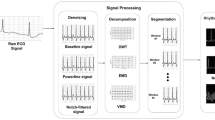Abstract
Ventricular tachyarrhythmia (VTA), mainly ventricular tachycardia (VT) and ventricular fibrillation (VF) are the major causes of sudden cardiac death in the world. This work uses deep learning, more precisely, LSTM and biLSTM networks to predict VTA events. The Spontaneous Ventricular Tachyarrhythmia Database from PhysioNET was chosen, which contains 78 patients, 135 VTA signals, and 135 control rhythms. After the pre-processing of these signals and feature extraction, the classifiers were able to predict whether a patient was going to suffer a VTA event or not. A better result using a biLSTM was obtained, with a 5-fold-cross-validation, reaching an accuracy of 96.30%, 94.07% of precision, 98.45% of sensibility, and 96.17% of F1-Score.
Access this chapter
Tax calculation will be finalised at checkout
Purchases are for personal use only
Similar content being viewed by others
References
Electrophysiology, task force of the European society of cardiology the north American society of pacing: heart rate variability: standards of measurement, physiological interpretation, and clinical use. Circulation 93(5), 1043–1065 (1996)
Faust, O., Shenfield, A., Kareem, M., San, T.R., Fujita, H., Acharya, U.R.: Automated detection of atrial fibrillation using long short-term memory network with RR interval signals. Comput. Biol. Med. 102, 327–335 (2018)
Goldberger, A.L., et al.: PhysioBank, PhysioToolkit, and PhysioNet: components of a new research resource for complex physiologic signals. Circulation 101(23), e215–e220 (2000)
Joo, S., Choi, K.J., Huh, S.J.: Prediction of ventricular tachycardia by a neural network using parameters of heart rate variability. In: 2010 Computing in Cardiology, pp. 585–588. IEEE (2010)
Karal, Ö.: Performance comparison of different kernel functions in SVM for different k value in k-fold cross-validation. In: 2020 Innovations in Intelligent Systems and Applications Conference (ASYU), pp. 1–5. IEEE (2020)
Monteiro, S., Leite, A., Solteiro Pires, E.J.: Deep learning on automatic fall detection. In: 2021 IEEE Latin American Conference on Computational Intelligence (LA-CCI), pp. 1–6 (2021). https://doi.org/10.1109/LA-CCI48322.2021.9769783
Parsi, A., O’Loughlin, D., Glavin, M., Jones, E.: Prediction of sudden cardiac death in implantable cardioverter defibrillators: a review and comparative study of heart rate variability features. IEEE Rev. Biomed. Eng. 13, 5–16 (2019)
Peng, C.K., Havlin, S., Stanley, H.E., Goldberger, A.L.: Quantification of scaling exponents and crossover phenomena in nonstationary heartbeat time series. Chaos: Interdisc. J. Nonlin. Sci. 5(1), 82–87 (1995)
Pincus, S.M.: Approximate entropy as a measure of system complexity. Proc. Natl. Acad. Sci. 88(6), 2297–2301 (1991)
Riasi, A., Mohebbi, M.: Prediction of ventricular tachycardia using morphological features of ECG signal. In: 2015 The International Symposium on Artificial Intelligence and Signal Processing (AISP), pp. 170–175. IEEE (2015)
Sanghera, R., Sanders, R., Husby, M., Bentsen, J.G.: Development of the subcutaneous implantable cardioverter-defibrillator for reducing sudden cardiac death. Ann. N. Y. Acad. Sci. 1329(1), 1–17 (2014)
Sengupta, S., et al.: Emotion specification from musical stimuli: an EEG study with AFA and DFA. In: 2017 4th International Conference on Signal Processing and Integrated Networks (SPIN), pp. 596–600. IEEE (2017)
Siami-Namini, S., Tavakoli, N., Namin, A.S.: The performance of LSTM and BiLSTM in forecasting time series. In: 2019 IEEE International Conference on Big Data (Big Data), pp. 3285–3292. IEEE (2019)
Taye, G.T., Hwang, H.J., Lim, K.M.: Application of a convolutional neural network for predicting the occurrence of ventricular tachyarrhythmia using heart rate variability features. Sci. Rep. 10(1), 1–7 (2020)
Author information
Authors and Affiliations
Corresponding author
Editor information
Editors and Affiliations
Rights and permissions
Copyright information
© 2023 ICST Institute for Computer Sciences, Social Informatics and Telecommunications Engineering
About this paper
Cite this paper
Barbosa, D., Pires, E.J.S., Leite, A., Oliveira, P.B.d.M. (2023). Prediction of Ventricular Tachyarrhythmia Using Deep Learning. In: Cunha, A., M. Garcia, N., Marx Gómez, J., Pereira, S. (eds) Wireless Mobile Communication and Healthcare. MobiHealth 2022. Lecture Notes of the Institute for Computer Sciences, Social Informatics and Telecommunications Engineering, vol 484. Springer, Cham. https://doi.org/10.1007/978-3-031-32029-3_5
Download citation
DOI: https://doi.org/10.1007/978-3-031-32029-3_5
Published:
Publisher Name: Springer, Cham
Print ISBN: 978-3-031-32028-6
Online ISBN: 978-3-031-32029-3
eBook Packages: Computer ScienceComputer Science (R0)




